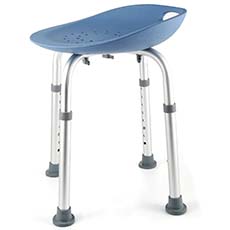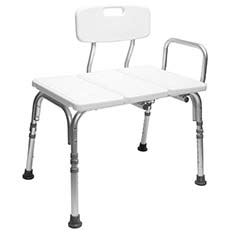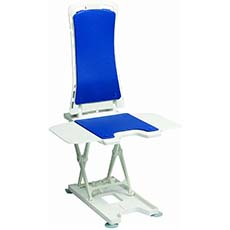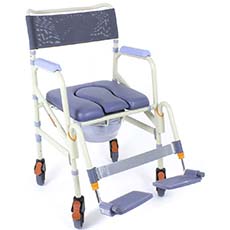Alternatives to walk-in tubs
8 cheaper and more versatile options

A walk-in tub offers great safety features and therapeutic benefits — if it’s in your budget. Even basic soaking tubs cost at least $2,000, not including installation. Especially for people on Social Security, the cost to install a new walk-in tub can be expensive — though there are ways to make a walk-in tub more affordable.
Even if you can afford one, the plumbing and installation might be a hassle. And if you ever sell your house, the tub may or may not add value.
So, what are some easier (and cheaper) ways to make bathing safer? Shower grab bars and anti-slip mats can prevent falls once you’re inside the tub, though they aren’t much help with getting in and out of the bath. Instead, consider a transfer bench or shower chair to steady yourself.
If what you really want is an at-home spa, you might be better off with a hot tub. A medical alert system is something else to consider, especially if you live alone. It’s more affordable than installing a walk-in tub, and you can find waterproof devices with automatic fall detection.
Depending on what you hope to get out of your walk-in tub, one of these alternatives might do the trick.
1. Shower chair
Much like it sounds, a shower chair is a waterproof seat with four legs. These usually cost between $30 and $200. Higher-end models come with backrests and padding for extra comfort.
You can find these online and at stores like Lowe’s, Home Depot and Walgreens. Consider costs, frame materials and weight limits to find the best shower chair for you. They’re usually eligible for flexible spending account (FSA) and health savings account (HSA) reimbursements.
Our shower chair pick
Remedic Safety Shower Chair
|
|
2. Transfer bench
Bath transfer benches make getting in and out of the tub easier. They come with a handle so you can steady yourself as you swing your legs in and slide over into the tub.
A transfer bench generally costs between $50 and $300. Most are eligible for FHA or HSA reimbursements.
Our transfer bench pick
Carex Tub Transfer Bench
|
|
3. Bath lift
Bath lifts usually have a high back and open sides. Most run on batteries and come with a remote control. Some models recline; others are set in an upright position.
A bath lift is similar to a transfer bench but does more of the work for you. You press a button to raise your seat to the tub’s height to get in or out. For bathing, you can lower the seat into the basin. Bath lifts prices are usually between $300 and $1,000.
Our bath lift pick
Drive Bellavita
|
|
4. Rolling shower chair
A rolling shower chair is like a transfer wheelchair, except it’s waterproof and specifically designed for use while bathing.
This type of chair can be good for anyone with limited mobility issues. It’s also popular among caregivers. Rolling shower chairs cost anywhere from $300 to $1,500.
Our roll-in shower chair pick
Showerbuddy
|
|
5. Walk-in shower
A walk-in shower isn’t much cheaper than a walk-in tub, but it’s a possible alternative for anyone who wants a low step threshold (safer entry) plus more versatile design options. These showers range in cost from $800 to $15,000.
The main difference between a walk-in shower and a walk-in tub is that you can sit or stand once you’re inside the shower. In combination with a rolling shower chair, it could be a practical solution for a safe, wheelchair-accessible bathing space.
- Pros: Customizable designs; optional safety features; takes up less space
- Cons: Expensive; complicated installation
6. Hot tub
A hot tub won’t be the best alternative for everyone. It’s not a solution for safer bathing, but it can provide some similar benefits to walk-in tubs, like massaging jets, built-in LEDs and remote control panels. Depending on the size and style you want, a hot tub could cost anywhere from $2,000 to $16,000.
- Pros: Easier to install; therapeutic benefits
- Cons: Not for bathing or washing
7. Medical alert system
Compared to the price of walk-in tubs, medical alert costs are relatively affordable (and more transparent). You usually pay a monthly subscription fee, typically $20 to $60.
A medical alert system won’t prevent falls, but it could make it easier to get help if a fall happens in the shower or somewhere else. Depending on which device or watch you choose, feature options might include caregiver apps, fall detection and GPS.
Still, this option doesn't make sense for everybody. Check out some questions to ask before you buy a medical alert system.
- Pros: 24/7 professional monitoring service; more affordable; lightweight devices
- Cons: Doesn’t detect 100% of falls
8. Senior living options
Some people think getting a walk-in tub will help them stay in their homes longer. It’s typical to want to keep a sense of independence, and some aging-in-place modifications can help, including walk-in tubs and stair lifts. Whether or not it’s a strategic investment depends on your long-term care needs.
- Assisted living: Signs it’s time for assisted living include recent falls and worsening health problems. It costs an average of $4,300 per month, and, of course, there are pros and cons.
- In-home care: Depending on your needs, paying for in-home care can cost even more than assisted living. On the plus side, though, you get the perks of staying at home plus the help of professionals.
- Nursing home: Nursing homes can offer the highest level of care for older people, but they aren’t cheap. Costs average about $8,000 to $9,000 per month.
For more, check out our tips for picking a senior living option.
Bottom line
The chance of serious bath- and shower-related injuries increases with age, according to the Centers for Disease Control and Prevention. So, if you (or your loved ones) are starting to feel uneasy, it’s best to make a change — whether that's as simple as upgrading to a nonslip mat or installing grab bars or making a big investment in a walk-in tub.
“If it was me, I’d probably just want a shower chair and a shower I could walk into without a step,” Marcy Baskin, Vice President of Senior Care Authority, said. Baskin’s job is to advocate for people as they age.
If it was me, I’d probably just want a shower chair and a shower I could walk into without a step.”
Other more affordable solutions include bath lifts and benches. Walk-in showers and hot tubs are still on the pricey side, but they are more versatile. A medical alert service or assisted living facility could be worth considering for those who live alone or struggle with daily tasks, such as bathing or climbing stairs.
According to Baskin, it’s extra important to do your homework on these kinds of purchases. If you’re buying for an older loved one, make sure to approach the decision with kindness and sensitivity.
You’re signed up
We’ll start sending you the news you need delivered straight to you. We value your privacy. Unsubscribe easily.






